Improving our service to America’s innovators
Vaishali Udupa, Commissioner for Patents
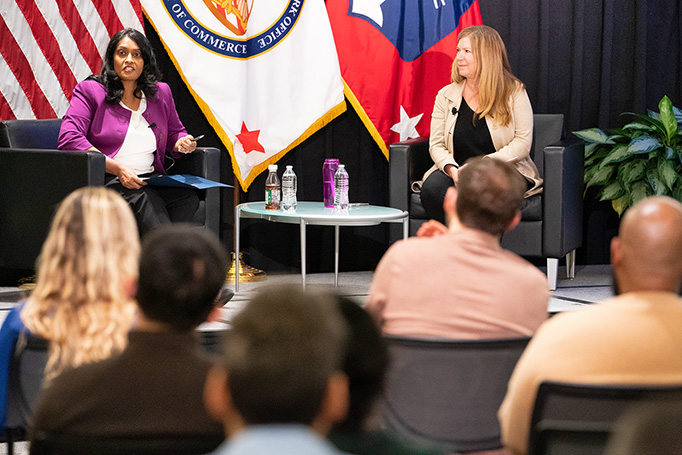
As we announced in September, as part of our modernization efforts to provide more extensible technology and functionality, the EFS-Web and Private Patent Application Information Retrieval (Private PAIR) tools are being retired after their decades of use as electronic filing and application management systems for our Patents customers.
Starting November 15, 2023, the Patent Center system will fully replace EFS-Web and Private PAIR.
Making this transition to Patent Center is essential to ensuring that our tools evolve, that we stay up to date on the latest digital capabilities, and that we continue to deliver excellent customer service to meet your needs.
We are postponing the original transition date (previously November 8) to better respond to and incorporate additional valuable stakeholder feedback into the Patent Center system. Specifically, we are working to increase usability for sponsored accounts with large amounts of customer numbers and address any related issues. We are also ramping up coverage to our Electronic Business Center to respond to questions in real-time and help ensure a smooth transition for our stakeholders.
A one-stop shop for Patents customers
Patent Center pulls all the steps of filing and managing a patent application together into one central system. It offers a next-generation user interface and better overall system performance and security. Patent Center also includes new features to streamline the application process:
- No need to create a new account: you can use the USPTO.gov accounts and sponsorships that you’ve already created for EFS-Web and Private PAIR.
- The ability to upload your patent application specification, claims, abstract, and drawings in a single DOCX document without having to manually separate sections.
- The ability to upload multiple documents at once using the drag and drop interface.
- The ability to download multiple documents at one time in a single PDF or ZIP file.
- The ability to confirm the status of submitted documents and successful payments with separate submission and payment receipts.
- In addition, if you want to get familiar with Patent Center’s features without actually submitting anything, you can explore Training Mode, an interactive simulation to safely practice filing DOCX and PDF documents. You’ll also receive real-time feedback.
Future updates
We’re not stopping here. Since its launch six years ago, we’ve rigorously tested Patent Center and made improvements based on your feedback. We will continue to use your input to enhance the system’s functionality. If you have a suggestion or an idea for new functionality or performance improvement send them to emod@uspto.gov. We review these ideas weekly. Retiring our legacy EFS-Web and Private PAIR systems ensures that we are better protecting confidential application materials and investing patent user fees responsibly. Maintaining these legacy systems during the development and testing of Patent Center made sense to ensure there was no interruption in service. Patent Center is now ready to become the sole system, and it is time to turn off the legacy systems so we can reinvest recovered resources into developing your ideas for new functionality and performance improvements. You can access instructional guides, resources, our on-demand webinar, a list of top 25 questions and answers from previous training sessions, and contact information for technical assistance all on the Patent Center information webpage. Thank you for all the feedback you’ve provided in Patent Center’s six years of operation. We appreciate your continued engagement as we seek to improve our service to you.
Posted at 01:41PM Nov 07, 2023 in ip | Comments[8]
What to expect from our new trademark search system (and why we’re replacing TESS)
Guest blog by Dave Gooder, Commissioners for Trademarks
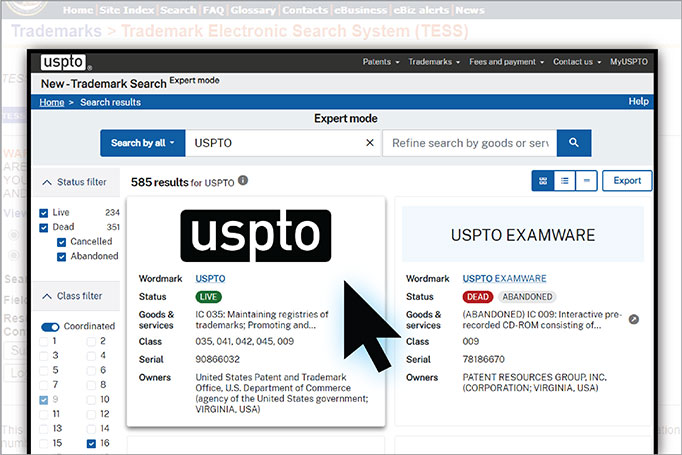
The Trademark Electronic Search System (TESS) has been a fixture of the USPTO’s information technology portfolio for decades. Those of us in the trademark community have grown accustomed to it, and perhaps even grown fond of it over the years. Maybe you have field tags and design search codes memorized, and you can formulate complex search strings to pull up the exact mark you’re looking for in a snap.
Although TESS has served us well, its long tenure is ending in November. The Bibliographic Retrieval System that has underpinned our internal and external search systems since 1993 is now outdated. On the bright side, we now have an opportunity to provide a more stable, modern search experience that can grow and adapt to the ever-evolving needs of the trademark community.
Our new search system recently launched in beta and we need your help to further its development. Our priority now, especially in the beta phase, is listening to your perspective on what works and what doesn’t, in order to optimize your search experience. To this end, I encourage you to use, learn, and express your feedback and suggestions on the new search. Your feedback will guide how we prioritize and develop updates beginning in 2024 and continuing for the life of the search system.
We understand that acclimating to a new interface and search
syntax takes time and look forward to holding several virtual events to help you
get familiar with the new system:
·
Demo
of the new trademark search system, September 26, 11 a.m. to noon ET
· Demo of the new trademark search system, September 28, 3-4 p.m. ET
·
Federal
trademark searching: Basics, October 2, 2-3:30 p.m. ET
· Federal trademark searching: advanced techniques, October 16, 2-3:30 p.m. ET
Thank you for the valuable feedback you’ve provided thus far, and please keep it coming. As we strive to transform your search experience for the better and to strengthen our IT infrastructure, we’re grateful for your support and engagement.
Posted at 11:18AM Sep 25, 2023 in trademarks | Comments[8]
Supporting our military community
Note: This blog originally published on the Commerce blog.
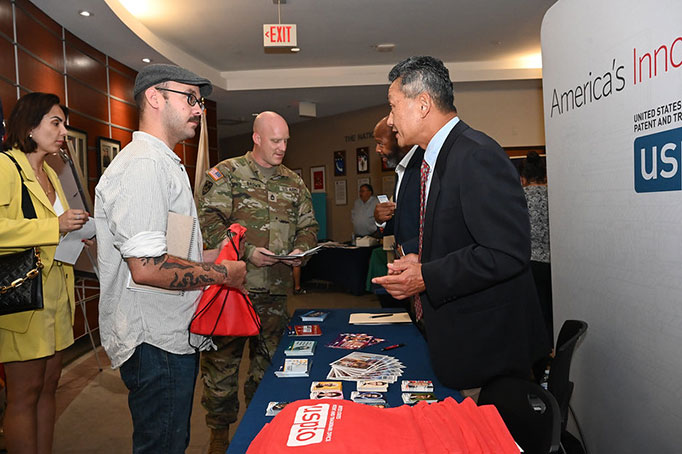
USPTO staff Alford Kindred and Harry Kim share entrepreneurship resources with military personnel and spouses at Hanscom Air Force Base (Photo courtesy of Todd Maki, Hanscom Air Force Base)
Last week, Secretary of Commerce Gina Raimondo joined Under Secretary of Commerce for Intellectual Property and Director of the USPTO Kathi Vidal at Hanscom Air Force Base, Massachusetts, for an Entrepreneurship Essentials Workshop and Resource Fair.
Over 100 military personnel, military spouses, and veterans attended in-person, with hundreds more online, as they heard from experts in business development and intellectual property (IP). Successful military spouses and veteran entrepreneurs discussed how they started businesses, and the resources and tools that helped them. From honing a business plan to protecting a brand and ideas, to market analysis and financing, the event included tips and resources on every angle of entrepreneurship.
“We want to figure out how to get the resources that we have within the Commerce Department, including at the USPTO, to assist veterans and their families,” Secretary Raimondo said.
Just a few weeks ago, President Biden signed an executive order to boost the economic and career prospects for military spouses and veterans, including service members approaching retirement.
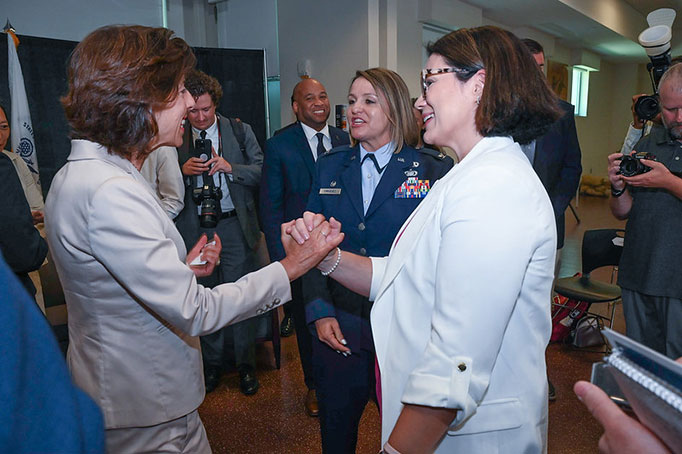
Secretary Raimondo greets Kim Howell, master of ceremonies for the Entrepreneurship Essentials Workshop and Resource Fair, and U.S. Coast Guard spouse (Photo courtesy of Todd Maki, Hanscom Air Force Base)
“President Biden is incredibly serious about supporting our service veterans and their loved ones,” Secretary Raimondo said in her remarks at Hanscom. “He has tasked each of us in his Cabinet about being proactive.”
Along these lines, the Secretary added, “the question is, what can we do at the Commerce Department?”
The answer, according to Secretary Raimondo, is for the Department to help veterans and their loved ones start businesses. She pointed out that the unemployment rate among military spouses is approximately 22% -- much higher than the national unemployment rate. Starting small businesses can help to reduce that spousal unemployment rate, while giving veterans and their families flexibility.
Also during the half-day event, Director Vidal pointed to the success that Hanscom has had with its Pitch It program. The program consolidates a wide range of technology market research functions, eliminating duplication and easing the pathway to public-private innovation.
“I was thrilled to learn about the work of the Hanscom Innovation Team, and the success you’ve had with your new Pitch It program,” Director Vidal told the Hanscom event on July 28. “We’d love to see it replicated throughout the country.”
“Entrepreneurship can be a game-changer for military spouses and for veterans,” said Director Vidal.
“For service members who are on the brink of making a leap into the civilian world, starting a business can be a viable second career.”
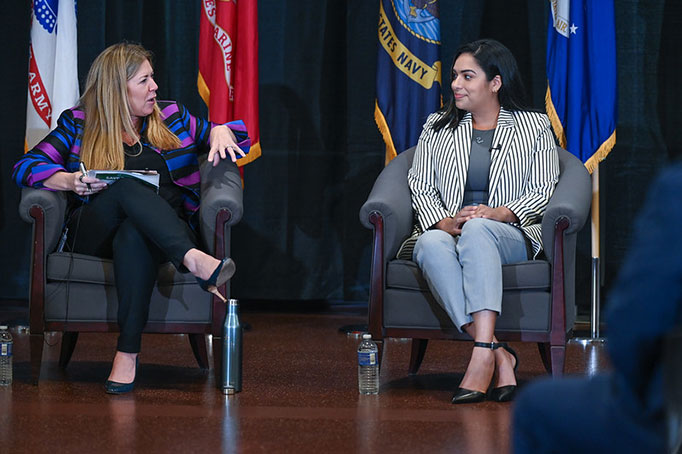
Director of the USPTO Kathi Vidal (left) speaks with Air Force veteran and entrepreneur Liseth Velez during a panel on business development resources (Photo courtesy of Todd Maki, Hanscom Air Force Base)
These efforts align with First Lady Jill Biden and the White House’s Joining Forces Initiative, which centers on employment and entrepreneurship; military child education; and health and well-being. The USPTO is working to support transitioning service members, military family members, and veterans to bring their innovations to life, build businesses, and protect their creations’ IP.
Across multiple agencies, including at the Commerce Department, the federal government under President Biden’s June 2023 executive order has been working to “increase the economic security of military and veteran spouses, caregivers, and survivors.”
The “bottom line is, we want to help you, we want to help you start a business, we want to help you grow your IP,” Secretary Raimondo told the military audience. “All the resources at the Commerce Department are available to you.”
Throughout the U.S., veterans own nearly two million businesses, which employ more than 5.2 million Americans, according to U.S. Census figures. At the USPTO, almost 10% of its 13,000-strong workforce is comprised of veterans, noted Director Vidal, whose father was both a veteran and an entrepreneur.
If you are affiliated with the military and interested in starting your own businesses, visit the USPTO’s entrepreneurship resources for the military community page or contact militaryoutreach@uspto.gov.
Posted at 11:20AM Aug 01, 2023 in ip | Comments[6]
Our plan for the future
Blog by Kathi Vidal, Under Secretary of Commerce for Intellectual Property and Director of the USPTO
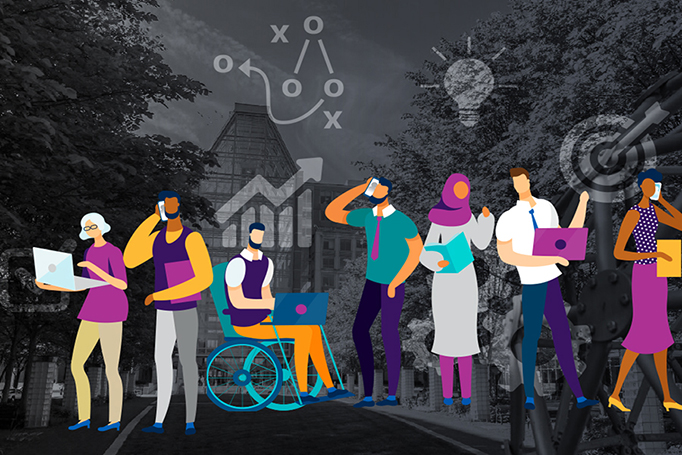
It’s been a work in progress for many months, and today, I’m excited to announce the publication of our 2022-2026 Strategic Plan. We gathered extensive comments from our employees, public advisory committees, IP industry groups, and the public to help shape this document into a clear and consistent plan. I’m grateful to everyone who provided feedback throughout the planning process to make this plan ambitious, focused, and relevant.
This plan outlines our five strategic goals for the next few years:
1. Drive inclusive U.S. innovation and global competitiveness;
2. Promote the efficient delivery of reliable intellectual property (IP) rights;
3. Promote the protection of IP against new and persistent threats;
4. Bring innovation to impact for the public good; and
5. Generate impactful employee and customer experiences by maximizing agency operations.
As you review the document, you’ll notice we’ve added measurable goal-based objectives to better quantify our continual progress. You’ll also see that we’ve modified our mission and vision to better reflect our position as America’s innovation agency.
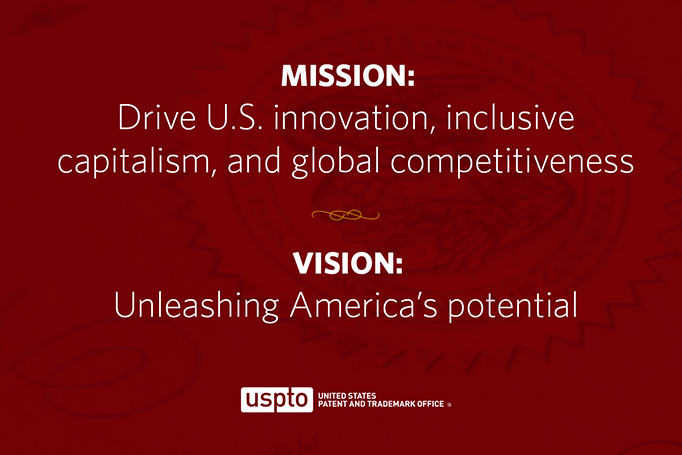
As I said in my one-year anniversary blog, my focus for the next 12 months is on impact. Between various engagement events and virtual feedback options, I’ve heard from thousands of you. We’ve listened. We’re reimagining our agency for the future. This plan clearly documents how we will achieve the greatest effects.
Every day, every one of us at the USPTO works to drive U.S. innovation, inclusive capitalism, and global competitiveness to unleash America’s limitless potential. I thank you all once again for joining us on this journey of evolution. As always, my virtual door remains open to you through the Engage with the Director page. We appreciate you and look forward to working with you to meet—and even exceed—our goals!
Posted at 10:19AM Jun 07, 2023 in ip | Comments[14]
Spotlight on Debbie Stephens: Driving change and modernization in information technology systems
Guest blog by Deborah Stephens, Deputy Chief Information Officer, United States Patent and Trademark Office

I am thrilled to continue to drive change in our information technology area and leverage my experiences to ensure OCIO aims for better ways to solve customer service issues, operates with more speed, and delivers powerful software and services. I am a firm believer that anything we do can be improved. We survey our staff for their ideas, we empower them to try, fail, learn, and succeed, and then we recognize them for the good work that they do. I am committed to listening to my staff and welcoming their ideas for change, so that we can keep improving for our employees and delivering value to our customers.
As a daughter of a strong mother, a wife, and a mother of a smart strong woman, I have been blessed to have many women role models during my life–none more important than my mother. Married at age 21 to a Navy pilot, and quickly uprooting herself from her small town in Horton, Kansas to join him around the world, my mother adapted to new cultures and languages all the while raising four children, managing the household, and the official duties expected of an officer’s wife. She is smart, strong, kind, funny, and the steadfast rock that our family has been built on. It is my honor to call myself her daughter. I learned love and compassion from her, and I learned to always tell the truth and to never stop trying to do better and learn more. I learned from her that a girl can do anything that a boy can do, and I went on to have a successful college experience as an Academic All-American college athlete at George Mason University, playing Division 1 softball while earning my Bachelor of Arts degree. I then went on to receive a Master of Human Resource Management degree from the George Washington University.
Additionally, I have met women in both my personal and professional career–such as the stay-at-home moms I worked with for 15 years in support of Girl Scouts at Fort Hunt Day Camp, organizing troop activities and selling Girl Scout cookies; their logistical expertise, ability to motivate and lead girls, many times doing it with a baby on the hip, and always with good humor—that have shown me how to evaluate situations from multiple and diverse lenses. I strive to learn from each encounter.
At the USPTO, I have had the fortune to work with and get to know women leaders from all areas within our organization. Women that have made their mark and gone on to new areas both within and external to the government, as well as women that have stayed for long periods of time at the USPTO. I have learned to be tenacious, detail oriented, to expect the best from everyone, and to always assume noble intent first and foremost.
Women’s History Month is meaningful to me in that it causes us to take a moment to acknowledge and reflect on the contributions that women have had towards the growth and prosperity of our country. The intellectual property community we support here at the USPTO has always had our fair share of smart and creative and industrious women that saw a need for a new way of doing things. These women were often granted patents and trademarks for inventions, businesses, and brands that contributed to the commerce and advancement of the U.S. Many great women are showcased during this month, and I want to acknowledge them. I also want to acknowledge women that may never have their name on a patent or trademark, the women that parent, the women that teach and support each other. And finally, the young women who are paving the way as the next generation of innovators. Together, we are a strong vibrant community that does great things–some large, some small—with empathy and concern for each other.
This blog is part of a series highlighting leaders across the Department of Commerce for Women's History Month.
Posted at 08:52AM Mar 13, 2023 in USPTO | Comments[5]
Increasing transparency, boosting competition, and supporting innovation can deliver better choices for farmers in the seed marketplace
Joint blog by Thomas J. Vilsack, Secretary of Agriculture, and Kathi Vidal, Under Secretary of Commerce for Intellectual Property and Director of the U.S. Patent and Trademark Office

Photo courtesy of USDA
The President outlined a multi-point plan to increase competition in the seed and agriculture space in his July 2021 Executive Order on Promoting Competition in the American Economy. Included in that plan is a call for the U.S. Department of Agriculture (USDA), in consultation with the U.S. Patent and Trademark Office (USPTO), to submit a report to the White House Competition Council on relevant concerns and strategies to help ensure “that the intellectual property system, while incentivizing innovation, does not also unnecessarily reduce competition in seed and other input markets.”
The Biden-Harris Administration, including the USDA and the USPTO, recognizes the importance of innovations in the seed and agricultural space, including ones that will mitigate climate-related disruptions to our food and agricultural systems. With more choices, and plant varieties tailored to local circumstances, farmers may gain potential revenue. In addition, diversifying variety development and production of seeds and other planting stock will make supply chains less vulnerable to disruption, give incentives to new market entrants to compete, and establish a fairer and more competitive market.
The investment in innovation in the seed and agriculture industry is made possible in part due to our intellectual property laws. The foundations of these laws were written into the U.S. Constitution by our nation’s founders, and innovators can utilize patents and plant variety protection to recoup and benefit from their investments during the limited terms provided. Indeed, USDA started its life as the then Patent Office’s Division of Agriculture, which for the first decades of our country distributed free seeds to farmers to promote agricultural production. Seeds were recognized over time as part of the intellectual property system through the Plant Variety Protection Act of 1970 and more recently through a series of court cases that recognized the availability of utility patents for seeds.
Today, the intellectual property system affecting seeds is diverse and robust. For example, the Plant Variety Protection Act permits farmers to save seeds for their own use and permits plant breeders to conduct research to develop the next variety. Our patent laws also allow for and encourage the disclosure of inventions, and for others to build on those innovations. These delicate sets of balances aim to reward and incentivize those who do the work to create original innovation, as well as protecting the public interest in continued innovation and fair competition.
But more must be done to ensure that the intellectual property system addresses the needs of agriculture today. While reliable intellectual property protection can incentivize seed and agricultural innovations, our patent system must not be used to unnecessarily reduce competition beyond what is reasonably contemplated by the law.
To further the objectives of President Biden’s Executive Order, the USDA recently completed its report in consultation with the USPTO Director, and the two agencies exchanged letters outlining numerous initiatives they will undertake to execute the President’s agenda. Under a newly established USDA-USPTO Working Group on Competition and Intellectual Property, these initiatives will strengthen our relationship and expand the resources available for assessing patentability and addressing instances of patents being used to unnecessarily reduce competition.
The joint initiatives of the new Working Group include:
1. exploring joint USPTO-USDA opportunities for collecting broader stakeholder input from researchers, plant breeders, farmers, and others in the seed and agricultural input markets,
2. exploring initiatives to enhance the quality of the patent examination process for innovations related to agricultural products and processes, including opportunities for enhancing prior art search capabilities and providing additional training and guidance to patent examiners,
3. collaborating on initiatives that enhance the transparency of IP information for agriculture-related innovations and assess availability and viability of patented and off-patented germplasm, and
4. considering and evaluating new proposals for incentivizing and protecting innovation in the seed and agricultural-related space, including the broader adoption of research or plant breeders’ exemptions when U.S. utility patents cover seeds.
The USPTO is eager to work with USDA’s new Farmer Seed Liaison to facilitate greater interaction between the agricultural sector and the IP system. The USPTO and the USDA will further collaborate to develop policies aimed at protecting and promoting U.S. innovation in the seed and agriculture space while advancing competition that will support farmers and supply chain resilience.
We invite the public to participate in this process through upcoming outreach events and listening sessions, and we look forward to hearing a diversity of views on these important topics.
For more information on the Biden Administration’s initiative in the seed space, please go to the USDA’s seed competition website.
Posted at 01:08PM Mar 07, 2023 in USPTO |
Free resources inventors and entrepreneurs need to know about
Blog by Kathi Vidal, Under Secretary of Commerce for Intellectual Property and Director of the USPTO
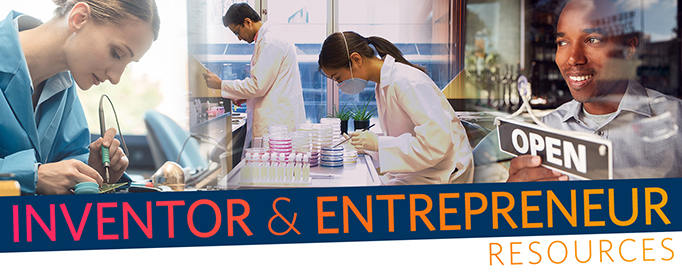
Patent and trademark basics
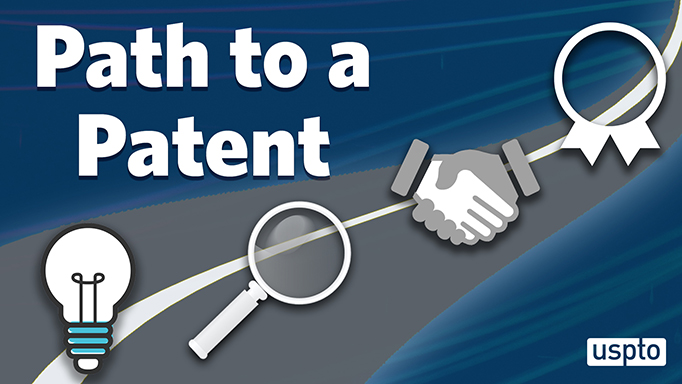
In addition, our Trademark Basics series is in its 10th cycle and is offered regularly throughout the year. Each module focuses on different aspects of trademarks and the registration process, from filing and examination to post-registration requirements for keeping your registration alive. And, of course, time for your specific trademark questions.
Patent and Trademark One-day Boot Camps
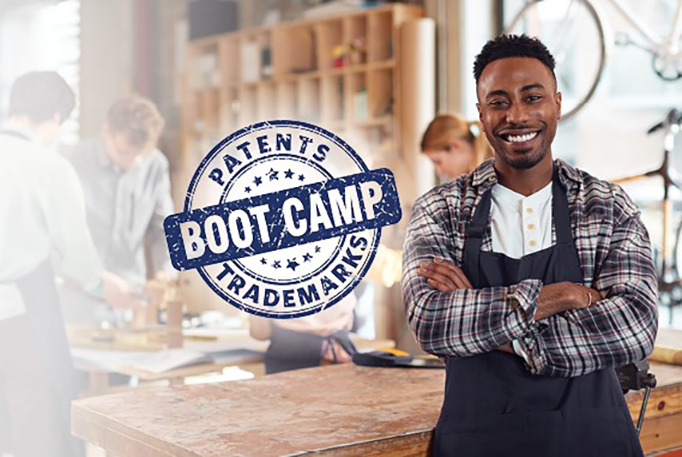
Free legal assistance (pro bono) programs
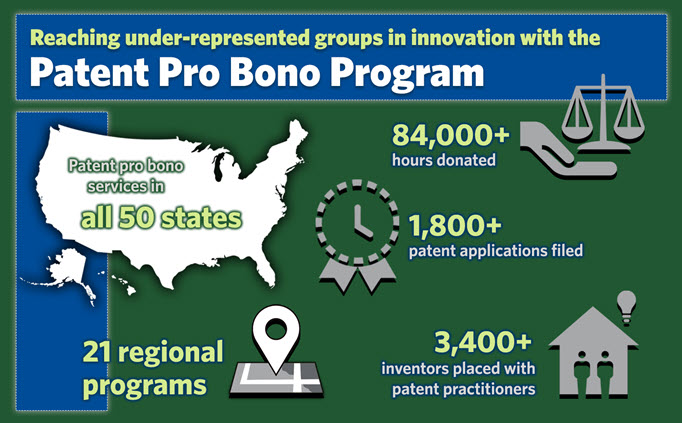
Law School Clinic Certification Program
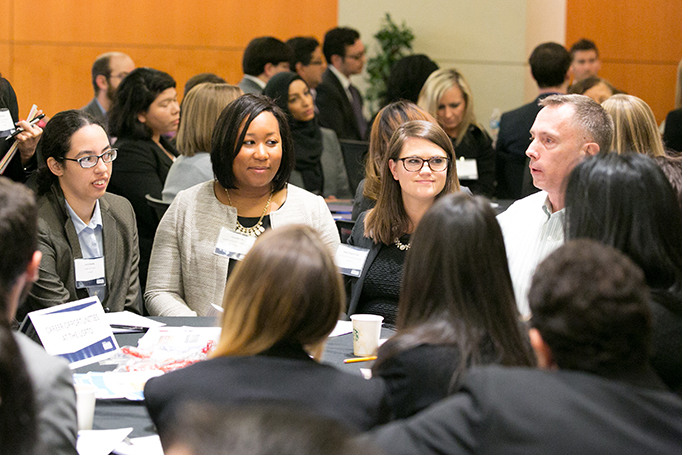
Additionally, our Law School Clinic Certification Program includes over 62 participating law schools that provide free legal services to eligible members of the public. Each year, students at the participating law schools assist numerous inventors, entrepreneurs, and small businesses with preparing, filing, and prosecuting patent and trademark applications. We recently announced that we have extended the submission deadline for the program to January 5, 2024, to encourage more law schools to join. With greater law school participation, we can make an even greater impact. Find out more about the Law School Clinic Certification Program and how your law school can apply to participate in the program.
Patent and Trademark Resources Centers (PTRCs)
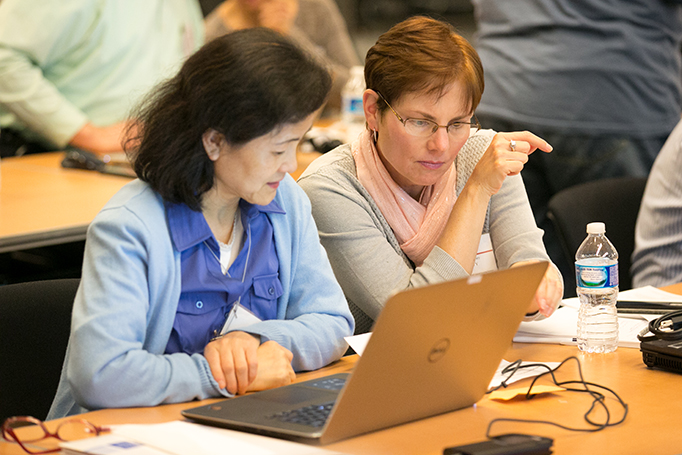
Another way to connect directly with someone for assistance with your IP questions is through our Patent and Trademark Resource Centers Program (PTRC). Located in more than 80 public, state, and academic libraries across the country, PTRC library staff are trained by the USPTO on how to use search tools to access patent and trademark information and connect individuals to our resources. They provide the human touch that no webpage or legal book can in helping inventors and small businesses find the information they need to protect their intellectual property. And very soon, the PTRCs will be providing training in even more locations. Find a PTRC near you!
Empowering Women’s Entrepreneurship (WE)
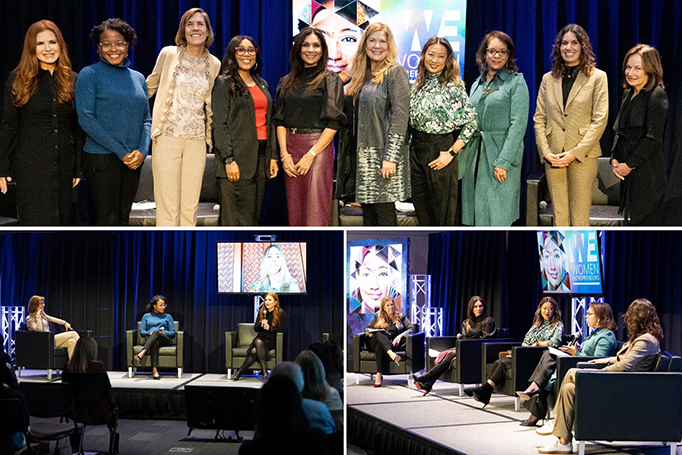
Launched in November 2022, our Women’s Entrepreneurship initiative is a community-focused, collaborative, and creative initiative to encourage and empower more women business founders across America. This program, which builds on the proven success of the USPTO’s Women’s Entrepreneurship Symposium, features advice from those who have made it as well as resources to help women protect their intellectual property, fund their ideas, and expand their network of mentors and advisors. WE is near and dear to my heart, as a former business owner, investor, and adviser.
These are just a few of our free resources available to inventors and entrepreneurs. To find more,
• Visit our Access Free Services page and Inventor and Entrepreneurs Resources page,
• Learn about upcoming programs on our events page,
• Subscribe to our email alerts to be the first to know the latest updates, or
• Contact us with questions or for more information!
Our goal is for the innovation system to be as diverse and inclusive as our country by working to provide equitable access for all. We hope to hear from you or see you at one of our upcoming trainings and events!
Posted at 12:23PM Mar 02, 2023 in USPTO | Comments[1]
The Unleashing American Innovators Act: Promoting inclusive innovation under the new law
Blog by Kathi Vidal, Under Secretary of Commerce for Intellectual Property and Director of the USPTO
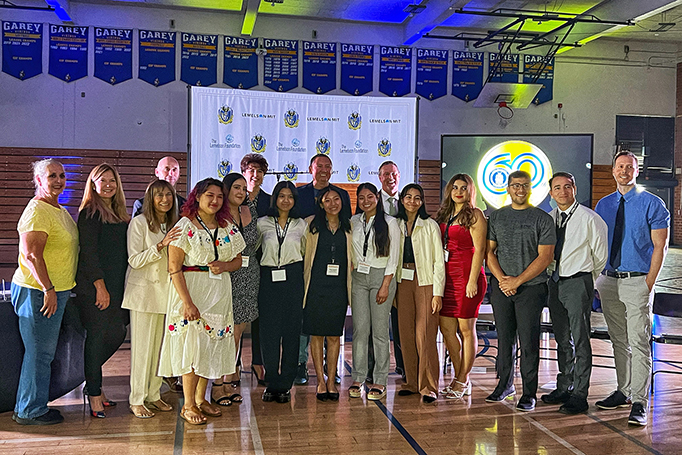
Since I took the helm of the USPTO in April of 2022, the USPTO has been working feverishly to unleash America’s potential. We immediately expanded our pro bono efforts, focused on outreach and impact, and are working on ways to better support those new to the innovation ecosystem. We are guided by the vision that by quadrupling the number of U.S. inventors, we can expand our economy, and GDP, by $1 trillion. We can create more and better jobs in more communities and give every American the opportunity, tools, and support to pursue the American dream.
With the support of Congress and President Biden, and the Senator Patrick Leahy-led Unleashing American Innovators Act of 2022, signed into law as part of the Consolidated Appropriations Act, 2023 on December 29, now is the moment to make lasting, sustainable change.
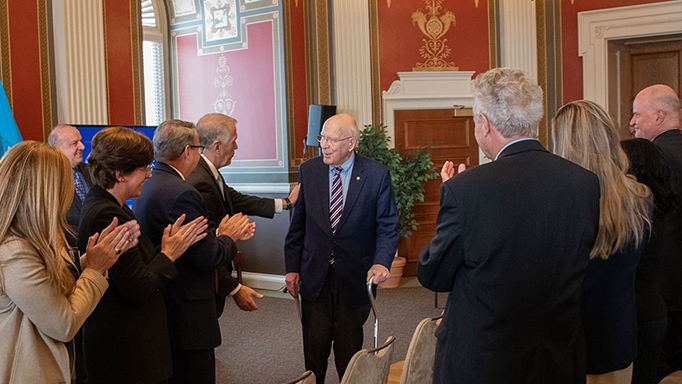
First, we must reach people where they are to bring them into the innovation ecosystem. The USPTO has been focused on outreach and impact, including the impact of the USPTO throughout the country. After hosting a two-day summit at our Rocky Mountain Regional Office in Denver, Colorado this past summer, we have been working on a plan to increase our geographic reach, and have been awaiting passage of the Unleashing American Innovators Act of 2022. Now that the bill is law, we are positioned to move forward quickly.
The bill supports USPTO’s expanded outreach efforts by requiring the USPTO to establish, within three years, a Southeast Regional Office, serving the States of Virginia, North Carolina, South Carolina, Georgia, Florida, Tennessee, Alabama, Mississippi, Louisiana, and Arkansas. The bill also requires the USPTO to report out within two years on whether additional offices are necessary to further increase participation in the patent system by individuals who have historically been underrepresented in patent filings.
In addition to satellite offices, the bill calls for the USPTO to establish community outreach offices within five years, including one in the New England region and in areas of the country where minority business owners are not as prevalent to help increase the number of underrepresented inventors and entrepreneurs in those areas.
Second, we must reduce the innovation ecosystem’s barriers to entry. As a fee-funded agency, we continually need to assess and adjust fees to ensure we are recovering costs to produce the most robust and reliable IP protection possible. This work is critical to the U.S. economy in securing investment, innovation and jobs in the U.S., and to advance an IP system that is accessible to all. Although small- and micro-entity fees help keep fees lower for those who are under-resourced, more needed to be done. Accordingly, the bill increased small entity discounts from 50 percent to 60 percent and micro entity discounts from 75 percent to 80 percent (view the updated USPTO fee schedule on our website).
While fees can pose a barrier to new entrants to our innovation economy, the fees charged by the USPTO are often dwarfed by the price of legal counsel. Recognizing that some applicants will need to proceed pro se (without legal counsel), the USPTO launched a Patent Pro Se Assistance Program to provide those applicants additional assistance on how to obtain a patent.
We have also been working since my first day to expand the USPTO’s Patent Pro Bono Program for independent inventors and small businesses. When we reach out and meet people where they are with pro bono legal services, we serve a broader group of constituents. Our data shows while the number of women inventors named on patents remains around 12-13%, the percentage of pro bono participants benefitting from our services is 41% women, 30% African American or black, 14% Hispanic American, 5.6% Asian American or Native Pacific Islander, and 1.5% Native American. In other words, pro bono counsel is providing critical assistance to underrepresented inventors and serving as the bridge to our innovation economy.
The bill supports our efforts to further build our pro bono programs, calling for us to complete a study within the next year on our pro bono programs and work with our Pro Bono Advisory Council, the regional program operators, and IP law associations across the country to implement meaningful changes that will help us expand efforts to provide free assistance to inventors and entrepreneurs. It also calls for the expansion of income eligibility to allow more innovators to benefit from these programs, putting the threshold at 400 percent of the federal poverty line as an individual’s gross household income. We are thrilled to continue this critical work.
Third, we must provide those new to the innovation ecosystem the education and support they need to be successful.
The USPTO offers extensive free services and courses to educate the public, including those new to the IP ecosystem, on ways in which IP protection can help them bring their ideas to reality and build successful businesses. A few examples of these resources:
• Our 8-part Path to a Patent series, next running from January 12 – March 16 , covers everything from IP basics, to patent searching, to what you'll need to draft and submit your patent application. Similarly, our 8-part Trademark Basics Boot Camp series provides a comprehensive overview of trademarks and the federal trademark registration process, including walking participants through the application filing process and concluding with a live question-and-answer period with a USPTO trademark expert. The next series kicks off January 10 and runs through February 28.
• Our Stakeholder Application Readiness Training (StART) provides training tailored to educate pro se applicants about the patent filing process and provides resources to submit a nonprovisional patent application.
• Our law school clinic program, which now includes over 60 participating clinics and provides legal services free to the public, including to inventors, entrepreneurs, and small businesses.
• Throughout the year, our Office of Innovation Outreach provides free events to inspire, educate, and empower underserved and under-resourced communities of innovators. The events feature successful independent inventors, entrepreneurs, and small business owners who share their personal stories of how they are using their patents and/or registered trademarks to reach their full potential, as well as subject matter experts who share information about funding/financial literacy, technical assistance, and mentoring/network programs. Working with partners from other federal agencies, organizations, and universities, the USPTO connects the public to valuable and timely information and resources at these events year-round.
• Our resources for kids, students, educators, and parents connect the K-12 community with engaging, fun activities (including inventor trading cards!) that bring out the innovator in all students and teach them about the importance of safeguarding ideas and businesses through intellectual property protection. Lots more to come on that in 2023, so stay tuned!
• Our inventor and entrepreneur resources provide inventors and entrepreneurs information to assist them at any stage of protecting their inventions and/or brand (e.g., education about the different types of IP, how to apply for a patent or trademark registration, assistance available after an application has been filed, etc.).
• Working across government and streamlining resources, our Council for Inclusive Innovation (CI²), of which I serve as Vice Chair and Secretary of Commerce Gina Raimondo as Chair, the National Advisory Council for Innovation and Entrepreneurship (NACIE) led by our sister agency the Economic Development Administration (EDA), and other collaboration opportunities with the military and veterans, the Minority Business Development Agency, Tribal Nations and communities, and more, work to eliminate barriers to the innovation system and meet people where they are with the resources they need to increase American innovation and entrepreneurship. Additionally, our recently-launched Women’s Entrepreneurship (WE) initiative serves to empower more women leaders and advance the conversation around challenges and opportunities for women-owned businesses.
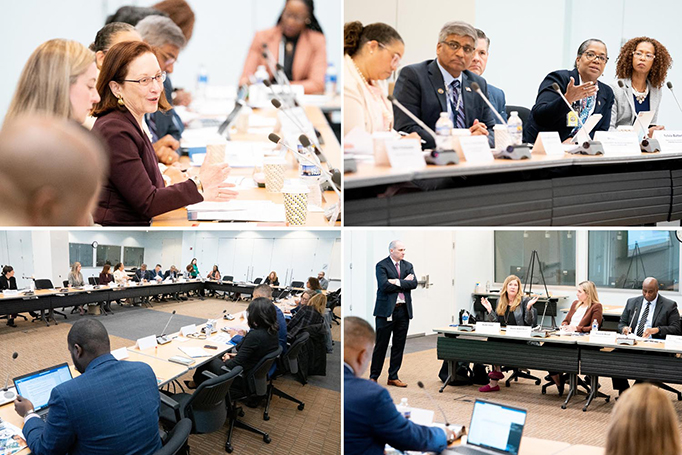
I have also spoken with individual inventors and small companies across the country to learn about their pain points. As a result, the USPTO is working on an expedited filing program to provide under-resourced first-time filers with expedited examination at no additional charge. We plan to announce the program later this month. As part of that program, applicants will be required to take certain key training to help ensure their success.
We are grateful that the bill provides us with the flexibility to explore more ways to assist first-time filers, including additional pilot programs to help them navigate the application process. Notably, the bill bolsters our work to support first-time applicants by establishing a pilot pre-prosecution assessment program, providing assistance to first-time prospective patent applicants in assessing the strengths and weaknesses of their potential patent applications.
I want to close by thanking and congratulating Senator Patrick Leahy and all those who worked hard to push the bill across the finish line. The bill complements our work to support small inventors, start-ups and those traditionally underrepresented in the innovation ecosystem. With the lower fees, additional outreach and support, and the expanded ability to obtain pro bono counsel, we are positioned to make meaningful progress in 2023 by measurably lowering the barriers for those entering the innovation ecosystem. As Secretary of Commerce Gina Raimondo remarked, “[a]s we successfully implement the programs” outlined in the bill, “the Biden Administration will continue showing that an economy that invests in the American people is an economy that will create shared prosperity for all.”
Posted at 08:57AM Jan 10, 2023 in USPTO | Comments[2]
Top three helpful tips for filing patent applications as you move to DOCX format
Blog by Kathi Vidal, Under Secretary of Commerce for Intellectual Property and Director of the USPTO; Andrew Faile, Acting Commissioner for Patents; and Jamie Holcombe, Chief Information Officer
Update: The USPTO has delayed the effective date of the non-DOCX surcharge fee to January 17, 2024, to give applicants more time to adjust to filing their patent applications in DOCX format, and has extended the backup PDF option until further notice. This blog has been updated to reflect these changes.

Thank you to all who have already moved to DOCX. Your feedback has helped up improve our processes to ensure DOCX works for all. It has helped up troubleshoot issues and provide guidance to stakeholders to ensure they do not make common mistakes that can be easily avoided. Though we encourage all applicants to move to DOCX as soon as they are able, for those needing some additional time, the USPTO, starting June 30, 2023, will allow applicants to file patent applications outside of DOCX upon payment of a fee (which will be discounted for small and micro entities). To help ease the transition to DOCX, we’ve also made several resources available on the DOCX page of the USPTO website.
To ensure a successful transition, we also wanted to share our top three helpful tips to ease the transition to DOCX:
1. Consider submitting an optional applicant-generated backup PDF, also known as the auxiliary PDF, with your application
We heard your ideas about filing an auxiliary PDF with your DOCX formatted application. In response to that suggestion, you can submit an applicant-generated auxiliary PDF of your application along with your DOCX version. While this opportunity was originally designed to be available until December 31, 2022, we have extended the program for six months through June 30, 2023. (Find out more in our Federal Register notice) Our hope is that this will provide you the confidence you need in filing with DOCX format, while providing peace of mind that the process is working as intended. There are currently no fees associated with submitting this auxiliary PDF, and it is completely optional.
2. Use the Auxiliary PDF (if necessary)
We’ve heard from some of you that you are concerned the validated DOCX version or the USPTO-generated PDF version may contain a discrepancy. Though we saw discrepancies in earlier versions of the tool, we considered your feedback and have updated the tool accordingly. It is now at a very advanced stage (version 18). We have not been seeing requests to rely on the auxiliary PDF discussed above. That said, if you have specific concerns, there are a few steps you can take.
The Electronic Business Center (EBC) is a great place to start. Please notify the EBC of any concerns with your electronic file as soon as possible. A trained representative can work with you to address your concern. You can reach the EBC at 866–217–9197 (toll-free), 571–272–4100, or ebc@uspto.gov 6 a.m. to midnight ET, Monday through Friday.
In addition to contacting EBC, there are other ways you can correct your application, such as:
• Making a correction to your application that is supported by the validated DOCX, by filing a petition under 37 CFR 1.181
• Making a correction to your application that is supported by an auxiliary PDF, by filing a petition under 37 CFR 1.182
• Making a correction to your application by relying on the incorporation by reference provisions of 37 CFR 1.57(b) with a proper priority benefit claim
You can find detailed information about the different ways to correct DOCX formatted applications in our DOCX FAQs..
We have also received questions about the role that auxiliary PDFs play if any discrepancies arise in USPTO-provided priority documents. Regardless of whether an application is filed in DOCX or PDF format, the USPTO provides a certified copy of the application-as-filed for use as a priority document using documents submitted on the application filing date and stored in the electronic application file, together with a certification sheet. If the USPTO makes any errors in providing a certified copy of an application, upon notification, the USPTO creates and sends a corrected certified copy of the application. This would be the same process should a discrepancy arise in the DOCX conversion to a USPTO-generated PDF. If an applicant files a patent application in DOCX format with an auxiliary PDF, the auxiliary PDF can be used as evidence in correcting the certified copy at the USPTO. If an applicant provides an auxiliary PDF of the application along with the DOCX version of the application at the time of filing, a copy of the auxiliary PDF is also included with the certified copy.
3. Use Patent Center training mode to test your DOCX-formatted application
Use the Patent Center training mode, which is an interactive simulation that allows you to practice filing using DOCX documents without officially submitting your patent application. You can use the training mode to familiarize yourself with other features in the new, modernized Patent Center, including a feedback document, which flags any errors in your application before you submit it. When you use training mode, you’ll have access to the same features and tools of the live Patent Center—except your application is not saved, data entered will not be submitted, and applications will not be associated with your customer number.
We’re working hard to make your transition to filing patent applications in DOCX as seamless as possible. To date, we’ve trained more than 20,000 people in our DOCX training sessions, gathered extensive feedback through our IdeaScale page, and addressed a litany of questions. In response to your feedback, we have also made office actions available in DOCX and XML formats and are now accepting DOCX for drawings, in addition to the specification, claims, and abstract, for certain applications.
And we are never done listening. We welcome your feedback and will continue to incorporate your suggestions wherever possible. Contact us at the Electronic Business Center at 866–217–9197 (toll-free), 571–272–4100, or ebc@uspto.gov 6 a.m. to midnight ET, Monday through Friday. Thank you for your help and support as we continue modernizing our systems for the benefit of all.
Posted at 08:59AM Dec 19, 2022 in USPTO | Comments[8]
Recognizing life-saving COVID-19 innovations
Blog by Kathi Vidal, Under Secretary of Commerce for Intellectual Property and Director of the USPTO
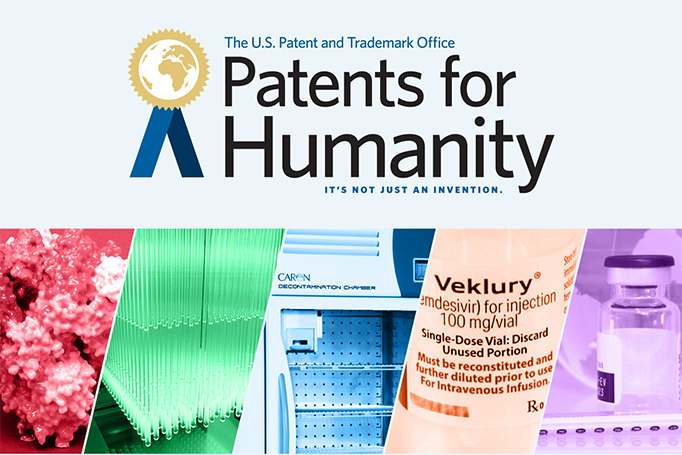
This year’s awards recognize innovators with a pending U.S. patent application or issued U.S. patent focused on inventions that track, prevent, diagnose, or treat COVID-19. The winning innovations, which receive acceleration certificates to expedite select proceedings at the USPTO, went through two rounds of judging by experts, based on two scoring criteria: the effectiveness of the technology to address COVID-19 and the technology’s ultimate impact.
The winners of the Patents for Humanity: COVID-19 category awards are:
National Institute of Allergy and Infectious Diseases (NIAID) (Rockville, MD)
NIAID, Scripps Research Institute, and Dartmouth College invented stabilized coronavirus spike proteins, which were essential to the development of the COVID-19 vaccines used today. The vaccines that incorporate these stabilized spike proteins have been instrumental in combatting the COVID-19 pandemic.
The breakthrough came when NIAID scientists and their collaborators engineered coronavirus spike proteins that enables the human immune system to mount effective responses against coronaviruses. This work cleared the path for the rapid development of the COVID-19 vaccines.
NIAID employed nonexclusive licensing to maximize use of the invention by as many vaccine developers as possible with the goal of accelerating vaccine development and global access. To facilitate this access, NIAID also partnered with the World Health Organization to promote the availability of the invention through its COVID-19 Technology Access Pool (C-TAP).
Regeneron Pharmaceuticals (Tarrytown, NY)
Regeneron Pharmaceuticals developed a novel therapy to help treat and prevent COVID-19. The medicine, known as REGEN-COV® in the United States, consisted of a combination of two monoclonal antibodies (casirivimab and imdevimab), and was the first to receive Emergency Use Authorization (EUA) from the U.S. Food and Drug Administration for the treatment of COVID-19. Anticipating that viruses can change over time, a key feature of Regeneron’s invention is how the two antibodies work to independently block the virus’s ability to infect healthy cells, which helped keep the therapeutic effective against multiple variants of SARS-CoV-2. Regeneron scientists developed the therapy for clinical trial use in five months, and received the EUA in ten months, moving from lab to patient in record time.
During the height of the pandemic, Regeneron made this treatment available to as many patients as possible in the United States. The U.S. Department of Defense and the Biomedical Advanced Research and Development Authority (BARDA), part of the Administration for Strategic Preparedness and Response at the U.S. Department of Health and Human Services, supported pre-clinical and late-stage clinical development, procurement, and distribution of REGEN-COV® in the United States at no cost to patients. In addition, Regeneron collaborated with global pharmaceutical company Roche to increase access to REGEN-COV® in the United States and globally.
University of South Florida (USF) (Tampa, FL)
USF developed 3D-printed nasal swabs used when nasal swabs used in covid tests were in short supply at the height of the pandemic. The USF Health Department of Radiology team and their colleagues from the USF Health Department of Internal Medicine Infectious Diseases worked with Northwell Health, New York's leading healthcare provider, to create the initial design and prototype for a 3D-printed nasal swab.
Completing a multisite national clinical trial out of Tampa General Hospital in two weeks, a process that typically takes years, the team produced a swab that cost between $0.25-$0.46 each, depending on an institution's print and lab resources, compared to an average of $1 each for commercially produced swabs.
The USF team collaborated with Formlabs to optimize the design and maximize the number of swabs that could be printed. In addition, USF allowed hospitals to use the swab design for free during the first year of production to help slow the spread of the virus. Since the first batches of 3D-printed swabs were processed, over 100 million of these USF Health–invented devices have been used in more than 60 countries.
Caron Products (Marietta, OH)
Caron Products developed a decontamination chamber that was used to disinfect personal protective equipment when it was in short supply during the height of the pandemic. When social distancing and proper hygiene were embraced globally, face masks and other Personal Protection Devices (PPDs) were in short supply. As a result, surgeries and other medical procedures were being cancelled due to the lack of availability of proper protective equipment for front-line nurses, doctors, and their patients.
Caron Products halted all other engineering research and new-product development projects to focus on developing an innovative means of decontaminating PPDs for reuse. The Caron team developed a decontamination chamber that uses vaporized hydrogen peroxide (H2O2) technology to quickly kill pathogens on both porous and non-porous surfaces, including PPDs. The development and commercialization of this technology helped relieve some of the strain on the supply chain for PPDs.
Gilead Sciences Inc. (Foster City, CA)
Gilead developed a widely effective antiviral medication used to treat COVID-19 known as remdesivir, one of the earliest therapeutics for COVID-19. Administered via injection, remdesivir works by blocking SARS-CoV-2 from reproducing in the body, and has been shown in clinical trials to help those with COVID-19 recover faster and reduce disease progression. Gilead has expanded access to remdesivir throughout the world by working with global generic pharmaceutical manufacturers. These arrangements allow the companies to manufacture generic remdesivir for distribution in 127 countries, the majority of which are low-income and lower middle-income countries. These agreements have been royalty-free, reflecting Gilead’s commitment to global equity and ensuring as many patients as possible had access to remdesivir at the height of the pandemic.
The ground-breaking technologies and solutions of the Patents for Humanity: COVID-19 category winners continue to make a difference in the lives of millions of people around the world facing the challenges of the pandemic. I also want to thank Senators Patrick Leahy (D-VT) and Charles Grassley (R-IA), and Representatives Hakeem Jeffries (D-NY) and Veronica Spartz (R-IN) for their leadership in sponsoring the Patents for Humanity Act, legislation that recently passed both chambers and codifies our Patents for Humanity program to incentivize more innovations for the benefit of all society.
We hope these success stories serve as inspiration for more individuals to harness innovation for human progress, and in doing so, change the world for the better.
Posted at 02:18PM Dec 15, 2022 in USPTO | Comments[1]

